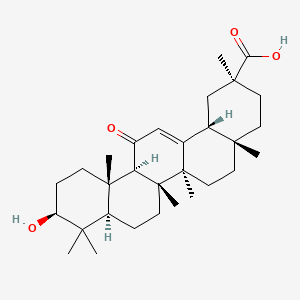Glycyrrhetinic acid
Glycyrrhetinic acid is a lipid of Prenol Lipids (PR) class. Glycyrrhetinic acid is associated with abnormalities such as Congenital Abnormality, Cortisol 11-beta-ketoreductase deficiency, Hypertensive disease, Mineralocorticoid Excess Syndrome, Apparent and Syndrome. The involved functions are known as Signal, Muscle Contraction, Pressure- physical agent, Agent and Metabolic Inhibition. Glycyrrhetinic acid often locates in Protoplasm, Body tissue, Muscle, Connexon and Extracellular. The associated genes with Glycyrrhetinic acid are SLC33A1 gene, GJB1 gene, RNU1-1 gene, HADHA gene and RNU1-4 gene. The related lipids are Steroids, Saponin, Octanols, Heptanol and amyrin.
References related to lipids published in Others
| PMID | Journal | Published Date | Author | Title |
|---|---|---|---|---|
| 11259395 | FASEB J. | 2001 | Oviedo-Orta E et al. | Immunoglobulin and cytokine expression in mixed lymphocyte cultures is reduced by disruption of gap junction intercellular communication. |
| 11748079 | Am. J. Physiol. Heart Circ. Physiol. | 2002 | Tare M et al. | Glycyrrhetinic derivatives inhibit hyperpolarization in endothelial cells of guinea pig and rat arteries. |
| 11756680 | Proc. Natl. Acad. Sci. U.S.A. | 2002 | Contreras JE et al. | Metabolic inhibition induces opening of unapposed connexin 43 gap junction hemichannels and reduces gap junctional communication in cortical astrocytes in culture. |
| 11997239 | Am. J. Physiol., Cell Physiol. | 2002 | Kolomytkin OV et al. | IL-1beta-induced production of metalloproteinases by synovial cells depends on gap junction conductance. |
| 15528254 | Am. J. Physiol. Gastrointest. Liver Physiol. | 2005 | Takeda Y et al. | Effects of the gap junction blocker glycyrrhetinic acid on gastrointestinal smooth muscle cells. |
| 16002718 | J. Immunol. | 2005 | Ukil A et al. | 18 Beta-glycyrrhetinic acid triggers curative Th1 response and nitric oxide up-regulation in experimental visceral leishmaniasis associated with the activation of NF-kappa B. |
| 25691644 | Antimicrob. Agents Chemother. | 2015 | Gupta P et al. | Antileishmanial effect of 18β-glycyrrhetinic acid is mediated by Toll-like receptor-dependent canonical and noncanonical p38 activation. |
